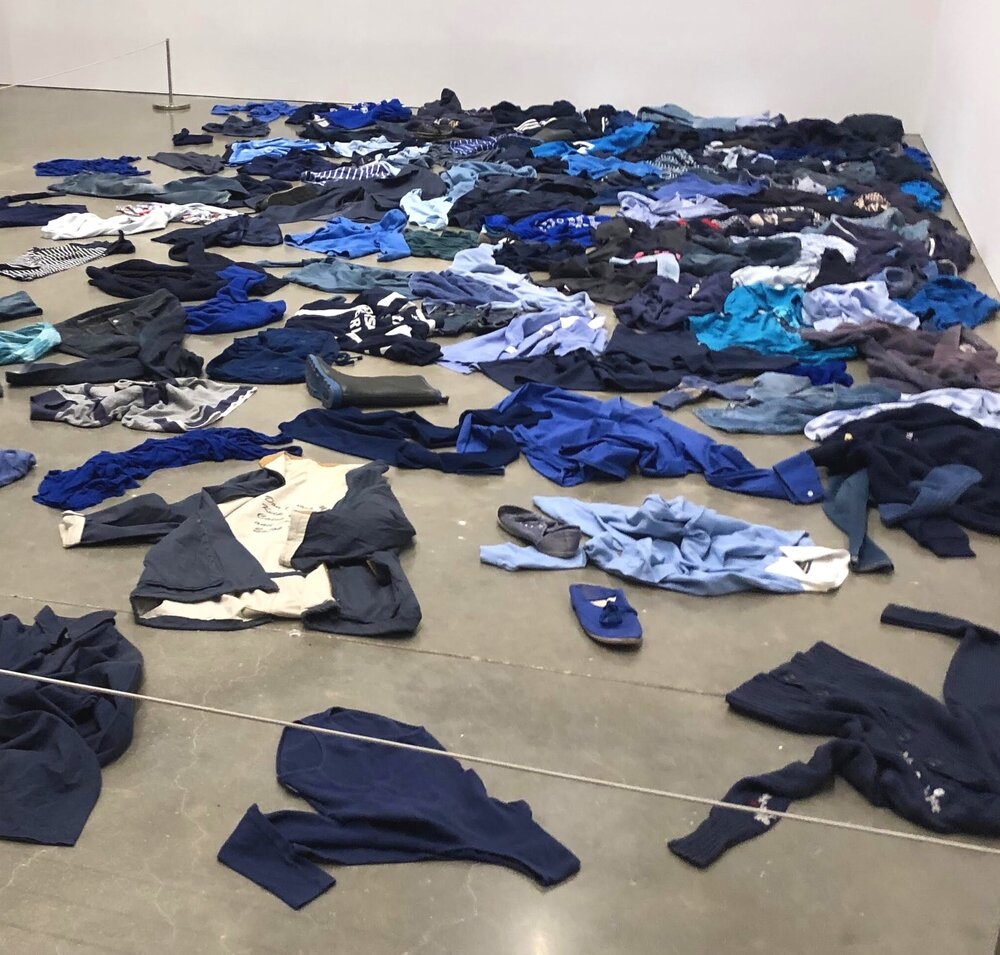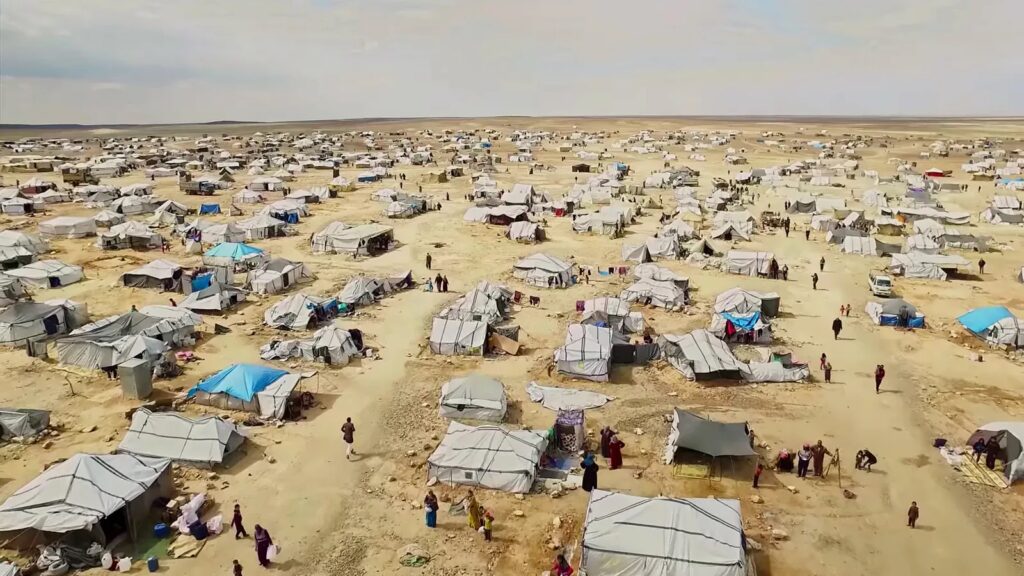Richard Vine
Human migration is ultimately political. This is obvious in cases of forced relocation, such as the expulsion of Christian Armenians from the Ottoman Em- pire—a geopolitical policy decision, entailing death marches and executions, that is obliquely but very touchingly evoked in Arshile Gorky’s canvas The Artist and His Mother (1926-36), which depicts the beloved parent who starved to death before her son’s eyes in 1919. Voluntary population shifts, the cumulative result of innumerable personal decisions, require an explanation such as Jacob Lawrence provided, point by point, in the sixty image-and-text panels of his painting series The Migration of the Negro (1940-41): “The migration was spurred on by the treatment of the tenant farmers by the planter. People (and before us our sapien ancestors) have moved about the surface of the earth, in large numbers either because they were compelled to do so by hostile forces or because they perceived living to be greatly more desirable in some locale other than their own. The two-volume Cambridge History of Global Migrations, which covers only from the year 1400 to the present, comprises over 1,300 pages devoted to factors such as war, trade, conquest, famine, pestilence, exile, debt, indenture, slavery, exploration, colonization, religion, urbanization, industrialization, labor flux, citizenship, and refugee status. All the commercial wealth and all the private charity in the world, one comes to realize, will never fully alleviate a problem that only international governmental action can fix.

In the past few years – due largely to the relentless flow of displaced persons from the global south to the global north in both the Americas and the Mediterranean Basin – the art world has been inundated with exhibitions focusing on migration. The most striking US examples include: The Warmth of Other Suns: Stories of Global Displacement (2019) at the Phillips Collection; Washington, DC, When Home Won’t Let You Stay: Migration through Contemporary Art (2019) at the Institute of Contemporary Art, Boston; Crossing Lines, Constructing Home: Displacement and Belonging in Contemporary Art (2019) at the Harvard Art Museums; how the light gets in (2019) at the Herbert F. Johnson Museum of Art, Cornell University, and A Movement in Every Direction: Legacies of the Great Migration (2022–2024), which traveled to five institutions. Abroad, the same preoccupation could be seen in myriad undertakings – for example, the five-part exhibition series Art and Migration: Who Are We? (2017-19) at Tate Exchange in Britain. Capping this global trend was the 2024 Venice Biennale, Foreigners Everywhere, visited by some 700,000 people over seven months.
Unfortunately, the critical upshot of this massive historical self-examination has been little more than the art world’s standard response to all social ills: blame capitalism. During the 2019 Warren Kanders controversy, some 120 public intellectuals sent the Whitney Museum an open letter lambasting institutional entanglement with “the power structures of settler colonialism, white supremacy, heteropatriarchy, and capitalism.” Meanwhile, art world intellectuals seldom if ever mention the millions of people uprooted and slaughtered in Russia, China, Eastern Europe, Southeast Asia, and Latin America to establish socialist or communist regimes. And they remain largely silent on the migration-causing horrors perpetrated within the global south itself by religious fanatics, dictators, cartels, and warlords. Instead, we are treated to the irony of hearing tenured professors and globe-trotting critics express disdain for the Western socioeconomic and political system, while themselves enjoying the legal protections and middle-class lifestyle that this system affords and that legions of the world’s dispossessed so desperately covet. Could there be a hint of subliminal guilt, even self-loathing, among these culturati caught up in a luxury trade that is utterly dependent upon the largesse – and speculative collector greed – of capitalism’s one percent?
Since ideology is impervious to argument, let’s turn instead to technique. Recent curatorial efforts reveal three major, closely interrelated ways that artists think and feel about migration: literalism, symbolization, and empathy. Beyond those formal approaches lies yet a deeper connection, a kind of ontological symbiosis, between artists and migrants, artworks and refugees. “We know so much and care so little,” Ai Weiwei told a Colorado audience when he won the International Artist of the Year award from the Anderson Ranch in 2018. He had just released Human Flow (2017), a feature-length film that documents, in minute daily particulars, the endless struggles of individuals who leave their homeland, cross treacherous seas or land borders, and strive to establish a foothold in an alien land. To make the work, which was first sparked when the artist witnessed refugees floundering ashore on the Greek island of Lesbos, Ai visited 40 detainment camps in 23 countries.

In many instances, the displaced individuals speak directly to Ai’s camera; in others, they interact, sometimes tearfully, sometimes jocundly, with the Chinese artist, who frequently repeats, “I respect you.” These intimate visuals are occasionally intercut with text reporting brutal statistics: the migrant crisis involves 68.5 million people, more than half under 18 years of age; the displaced spend an average of 25 years in camps; less than 5 percent ever succeed in attaining resident status in a new country; although media attention focuses on the US and Europe, 90 percent of the movement takes place in countries: Bangladesh, Myanmar, Pakistan, and others, that are neither wealthy nor at the forefront of Western consciousness. Ai’s direct involvement springs from his personal history. He grew up in remote Xinjiang Province, where his famed poet father, Ai Qing, scrubbed toilets in internal exile, one of the countless 20th-century intellectuals that Mao Zedong banished to the countryside. Having himself been detained in a secret location by the Chinese government (which is to say the Chinese Communist Party) for 81 days in 2011, Ai has no hesitation about calling out the world’s true oppressors, the direct creators of much (probably most) current migratory urgency. Thus his 2017 Hirshhorn Museum solo included the floor installation Trace (2014), featuring 176 Lego portraits of individuals imprisoned or exiled by explicitly named despotic regimes in 30 countries.

While few practitioners have Ai Weiwei’s art-star resources, many share his indexical method for humanizing archival finds and field research. Alfredo Jaar, whose projects include photographing exploit- ed goldmine workers in Brazil and representing a million Rwandan genocide victims through the closeup image of a sole woman’s traumatized gaze, has deftly encapsulated this personalized, fact- based method. At the Museum of Memory and Human Rights in Santiago, his Geometry of Conscience (2010) uses 500 photo-negative portrait silhouettes to evoke the approximately 1,500 people “disappeared” into prisons or graves by President Augusto Pinochet, whose 16-year dictatorship of Chile also spawned a million refugees. “Every work,” Jaar told Art21, “is a response to a real-life event, a real-life situation.” Taking the ultimate step, Tania Bruguera, in her Immigrant Movement International (2011-18), moved in with migrants living in Queens and established a volunteer center offering them free classes and social services.
Other artists prefer to use symbolic or diagrammatic imagery to render the refugee crisis both comprehensible and pungent. Thus Rena Saini Kallat constructs wall maps from circuit boards and electrical cables (some resembling barbed wire) to illustrate global trade and migration routes; Bouchra Khalili’s eight-channel video The Mapping Journey Project (2008-11) shows hands charting the multi-national odysseys of various displaced persons, who narrate their long treks in voiceover; Mona Hatoum’s Grater Divide (2002), a human-sized folding screen of serrated steel suggests the social and psychological transformations migrants must pass through to change their domicile from one country to another; Kader Attia’s floor-scattering of mostly blue clothing, The Dead Sea (2015), commemorates the countless refugees who have drowned in ill-fated international water crossings. The essence of such work is to distill multiple experiences into a single unforgettable visual emblem.
Imaginative identification with migrants, though always transient and imperfect, affords perhaps the most compelling access to their state of being. For three decades, Djamel Tatah, a son of Algerian immigrants to southern France, has painted pensive figures that resemble pale wandering spirits. The implicit point that migrants, however successfully they may integrate into their new environment, bear forever a dual identity and a sense of loss; echoed by myriad artists who make refugee testimony videos: Emily Jacir (Where We Come From, 2001-03), Candice Breitz (Love Story, 2016), Isaac Julien (Western Union: Small Boats, 2017), Hiwa K (Pre-Image [Blind as the Mother Tongue], 2017), and many others.

Each of the three artistic strategies discussed here entails the other two to some extent. And as Ai Wei- wei’s camp visits and Bruguera’s live-in project in Queens attest, nothing arouses empathy more efficiently than face-to-face interaction with the dispossessed. Certainly, that was the impact of Olafur Eliasson’s Green Light (2016), an itinerant workshop that began in Vienna and made its way to the Venice Biennale. Migrants and exhibition visitors chatted, joked, and commiserated as they shared in the fabrication of green go lamps, signifying hope for the refugees, who also received money from the sale of the items they produced.
Still, a question remains. Why does migration engage members of the art world to a greater and more intense degree than other equally serious social problems – gun violence, income inequities, ageism, healthcare costs, Islamic jihadism, Russian and Chinese aggression? The answer lies, in part, in the fact that so many artists are themselves genteel migrants. Raised in one country, educated in another, living in a third, and exhibiting their work world- wide, they wear the badge of global nomad proudly. Moreover, modern and postmodern art is itself a product of psychic displacement, in two ways. First, ever since the late 19th-century revolt of the avant-garde, membership in the world (really the club) of serious art has required a veritable self-exile – a renunciation of mainstream values and the dreaded “bourgeois” sensibility of the unredeemed majority, rife with false consciousness.
Second, at a quasi-metaphysical level, every art-maker performs an act of expulsion and transfiguration, wrenching materials from their normal state into something new and other the representation of an intangible idea or feeling.
Artists, in short, do to visual things what migration does to living beings; they create, in effect, émigré artefacts that alter any environment they enter, and are simultaneously changed by it. Call it cultural assimilation in process. Global contemporary art museums are, in effect, enclaves of deracinated objects and viewers, veritable high-culture Chinatowns, while galleries and auction houses serve as placement agencies for newly arrived migrant artworks. Those hybrid creations reassure us that we, the bohemian elite, are not alone in our displacement, our existential never-quite-at-homeness. Rather, here in the refugee camp of the art world, tiny, isolate, and overcrowded, we employ them to signal each other encouragingly, in a language all our own.

